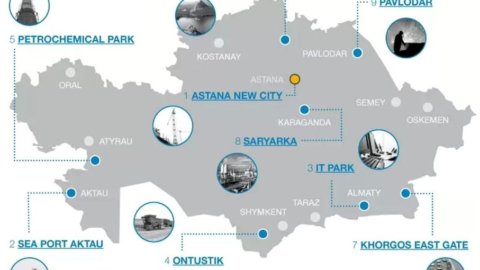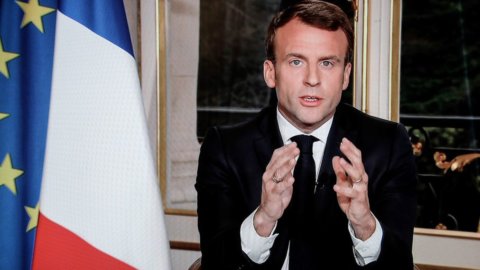Based on the data collected published by Intesa SanpaoloKazakh GDP growth slowed to a rate of 2012% in 5, from 7,5% in 2011 and an average of 8,4% in 2004-08, before the outbreak of the financial crisis. This slowdown was caused by the fall in agricultural production (-8,2%) due to drought conditions which led to a marked cut in the wheat harvest and by the drop in mining production represented by oil and gas condensate (-1,1%). The services sector confirmed itself as the most dynamic, registering an expansion in real terms of 9,6%, driven by sales, transport, communication and catering services, by the recovery of the real estate and financial sector. Manufacturing production, while slowing down significantly, remains in positive growth (+2,1%). The forecasts for 2013 speak of a GDP dynamic that will benefit from thestart of production at the important Kashagan oil field and the recovery, in the absence of adverse weather conditions, of agricultural production. And if, at the same time, manufacturing transformation and services follow this trend, GDP growth could return to around 2013% in 7, even in the presence of an external framework that is still not particularly favourable, to further accelerate in 2014, to 7,6%.
Kazakhstan is a country rich in fossil reserves (coal, gas and oil) and minerals (uranium, iron, copper, zinc) and, although the manufacturing sector (transformation of hydrocarbon goods, metals and agricultural products) and agriculture (wheat, cotton and livestock) are of some importance, the economy is mainly based on hydrocarbon extraction activities. Gas and oil supplyIn fact, nearly three-quarters of export earnings (plus a 15% share from metals) and nearly 50% of tax revenues. Furthermore, this sector absorbs three-quarters of the FDI flow (7,3% of GDP), fueling the processing industry (metalworking and petrochemicals), related services (transportation, maintenance, exploration) and infrastructure (road and air links, oil and gas pipelines). The proceeds from the sale of raw materials have in turn favored the development of the financial and real estate sectors.
The balance of payments recorded in 2012 a current surplus of 4,5% of GDP, determined by the large trade surplus (23,4% of GDP) which more than compensated for the income account deficit (14% of GDP) for the return on capital invested in the country. However, the financial account has closed in deficit in the last three years, mainly due to the reduction of capital intended for portfolio investment by foreign investors. At the end of 2012, foreign exchange reserves amounted to 21,6 billion dollars compared to a 2013 external financial requirement of 23,1 billion. However, to meet its foreign commitments, Kazakhstan also has a sovereign wealth fund, the National Oil Fund, created with proceeds from the sale of gas and oil, which at the end of 2012 had a capitalization of around 60 billion. Despite that, the banking sector still has a high share of non-performing loans and the financial position of many firms, especially those exposed to the real estate sector, remains weak. The limited diversification of the economy andexcessive dependence on the cycle of raw materials in fact, they represent dangerous factors of vulnerability which, in the absence of adequate institutional interventions in terms of rethinking commercial and credit strategies, risk jeopardizing the country's economic development in the long term.
EU, which absorbs almost 50% of exports and supplies just under a fifth of imports, it is Kazakhstan's largest trading partner, followed by the CIS countries (14% of exports and 52,2% of imports in 2011) and China (18,5% and 13% respectively). Furthermore, more than a third of FDI comes from the EU, while the Chinese share, equal to 10%, is destined to increase after the signing of cooperation agreements in the field of energy product processing, energy generation and infrastructure development. Relations with Russia are also expected to further develop, thanks to the launch of the Customs Union in 2010 and the formation, from the beginning of 2012, of the Common Economic Area between Kazakhstan, Russia e Belaruswithin the Eurasian Economic Community (EEC). In this scenario, Kazakhstan's trade increased from 23 billion in 2003 to 110 billion in 2008, marking a nominal average annual increase of 37%. The balance of trade, historically positive, reached a peak in 2011 exceeding 50 billion dollars, thanks to the growing exploitation of oil fields. Kazakhstan thus looks set to become one of the world's top five oil producers in the next decade. In 2012, the surplus amounted to just under 48 billion as a result of higher growth in imports than exports.
Among the EU countries, Italy is the main counterpart, with a share of the total Kazakh trade of around 13%, followed by the Netherlands (5,5%), France (5%) and Germany (3%). Where trade exceeded 5,5 billion euros in 2012, quintupling the value since 2004, Italian exports are historically lower than imports. The gap between the two flows has been growing over time and in 2012 exports were equal to around one fifth of imports. The latter are almost entirely represented by energy minerals (92%), followed by metals, petroleum derivatives, agricultural products and textiles, while exports are represented by mechanical machinery, electrical appliances and means of transport (60%), to which followed by textile and clothing products, metals and metal products.





